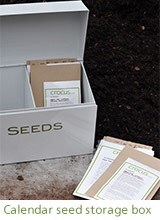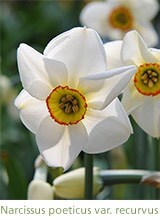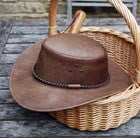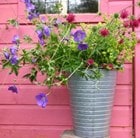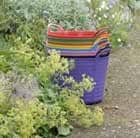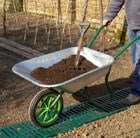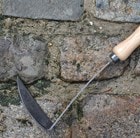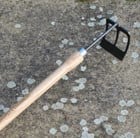|
Not surprisingly the Hydrangea breeders are working hard to provide some extra magic and the seaside favourite Hydrangea macrophylla, which used to come in girl/boy pinks and blues depending on your soil pH, is now a fashion statement. The black-stemmed, white flowered ‘Zebra’ and the sultry-stemmed bright pink ‘Black Steel Zambia’ will look good in a container or in the garden. You could try ‘Dark Purple’, although to keep the blue-toned purple intense you may have to feed with hydrangea colourant to add an acid element to your soil. Or you could plant it in ericaceous compost (in a stylish container) but do use water butt water for irrigation rather than tap water, which is alkaline.
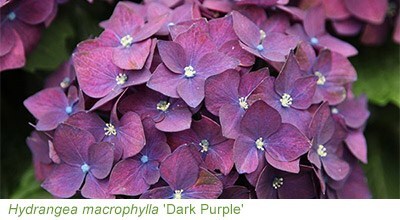
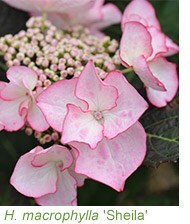 All the above varieties are Hydrangea breeders are working hard to provide some extra magic and the seaside favourite mopheads and these form domes of flower, but there are also daintier lacecap forms of H. macrophylla. These have large flowers round the edge (to attract the insects) and tiny sterile flowers inside. 'Sheila' (part of the Dutch Ladies Series) was bred for the cut-flower market because the outer mottled pink flowers have a dark pink picotee edge to their frilly-edged petals. Whichever form of H. macrophylla you grow, they prefer a cool root run in fertile soil. For this reason, many gardeners position them on the shady side of a low wall so that they emerge above. This position also offers winter protection because most H. macrophylla flower on old wood so the more stems you can preserve the better. New breakthrough breeding however has provided the ‘Endless Summer’ hydrangeas. These are guaranteed to flower on both old and new wood, giving a longer succession of flowers between June and October. There are both pink and blue forms, although the pink variety, when grown on acid soil, or if treated with Hydrangea breeders are working hard to provide some extra magic and the seaside favourite hydrangea colourant, will produce blue flowers. All the above varieties are Hydrangea breeders are working hard to provide some extra magic and the seaside favourite mopheads and these form domes of flower, but there are also daintier lacecap forms of H. macrophylla. These have large flowers round the edge (to attract the insects) and tiny sterile flowers inside. 'Sheila' (part of the Dutch Ladies Series) was bred for the cut-flower market because the outer mottled pink flowers have a dark pink picotee edge to their frilly-edged petals. Whichever form of H. macrophylla you grow, they prefer a cool root run in fertile soil. For this reason, many gardeners position them on the shady side of a low wall so that they emerge above. This position also offers winter protection because most H. macrophylla flower on old wood so the more stems you can preserve the better. New breakthrough breeding however has provided the ‘Endless Summer’ hydrangeas. These are guaranteed to flower on both old and new wood, giving a longer succession of flowers between June and October. There are both pink and blue forms, although the pink variety, when grown on acid soil, or if treated with Hydrangea breeders are working hard to provide some extra magic and the seaside favourite hydrangea colourant, will produce blue flowers.
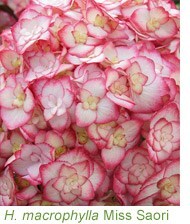 ‘Miss Saori’, Winner of RHS Chelsea Flower Show 'Plant of the Year 2014', is another newly bred hydrangea that also flowers on old and new wood, producing intricate pink and white double flowers. Pruning H. macrophylla is easy, just cut the stems down to the emerging buds in late spring. Also, remember that this native of China and Japan enjoys summer rain and warmth provided by the rainy season, which occurs for six weeks from early June in their native countries. Therefore, give your hydrangeas water in dry springs and find them a warm position. ‘Miss Saori’, Winner of RHS Chelsea Flower Show 'Plant of the Year 2014', is another newly bred hydrangea that also flowers on old and new wood, producing intricate pink and white double flowers. Pruning H. macrophylla is easy, just cut the stems down to the emerging buds in late spring. Also, remember that this native of China and Japan enjoys summer rain and warmth provided by the rainy season, which occurs for six weeks from early June in their native countries. Therefore, give your hydrangeas water in dry springs and find them a warm position.
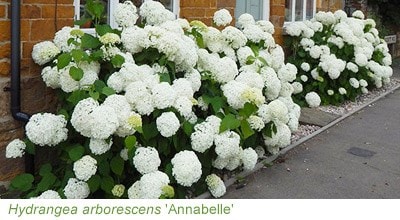
If your garden is cold or dry, the American species H. arborescens, found in the heartland of America, will still thrive because it’s used to the freezing snowy winters and hot, arid summers of Iowa. It will happily grow anywhere in Britain, regardless of rainfall or temperature, but looks best in light shade or full sun. The spectacular 'Annabelle' was discovered growing wild near Anna in Ohio, hence the name. Launched in the mid-1970s by the Gulf Stream Nursery, it is now widely available. The mushroom-shaped, almost semicircular cool white flowers appear from July onwards, but the green veining on the four "petals" (which are in fact long-lasting bracts) prevents 'Annabelle' from looking brash in summer sun. It’s cool and elegant and in rich soil will produce large heads of flower and make a large, impressive plant that gives a strong presence for more than six months.  Use it to highlight dark flowers and foliage, such as Cotinus coggygria 'Royal Purple’ and dark dahlias like the brown-red ‘Chat Noir’ and 'Arabian Night’. Colourful asters also look more vibrant close to cool white ‘Annabelle’. If you want football-sized flowers on rigid stems opt for the newly bred ‘Strong Annabelle’. There is also ‘Invincibelle’, the first pink form and this has interesting matt-green foliage and small pink flowers. Use it to highlight dark flowers and foliage, such as Cotinus coggygria 'Royal Purple’ and dark dahlias like the brown-red ‘Chat Noir’ and 'Arabian Night’. Colourful asters also look more vibrant close to cool white ‘Annabelle’. If you want football-sized flowers on rigid stems opt for the newly bred ‘Strong Annabelle’. There is also ‘Invincibelle’, the first pink form and this has interesting matt-green foliage and small pink flowers.
Some hydrangeas come to the fore in August and September and the shade-loving Hydrangea paniculata, native to southern and eastern China, Korea, Japan and Russia, produces conical heads, or panicles, similar in shape to the lilacs. These normally come in lime-green, white and subtle pinks and they can be used in very shady woodland borders to provide a late flourish of flower. They will even grow under huge trees, as they do at RHS Wisley’s Battlestone Hill. Forms of H. paniculata are easy and they should be hard pruned in early spring, so they won’t spoil the spring show with their bare branches. They can be cut low and still perform. Hard pruning produces smaller flowers that appear later. These can look better than enormous heads in some settings. You can make the choice. Big and lusty looks fabulous under large, mature trees, but more refined may be better in the garden setting.
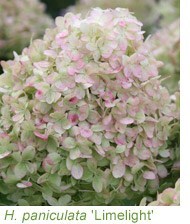 The easiest to place, perhaps, is ‘Limelight’ for its cool, pallid-green, modestly-sized flowers look delightfully luminous in shade and go with simply everything. They emerge like dilute limeade and then fizz away in the shade before turning cream. Hints of pink begin to speckle the heads in autumn so they fade beautifully and the heads can be left until late in the year, but then they will disintegrate and make a mess. ‘Little Lime’ is a compact descendent that has tighter, limier green flowers so this is perfect for a container. The recently bred ‘Bombshell’ is even smaller in stature, reaching three feet or almost a metre, but the lime-tinted cream flower heads are rounded on this bushy, compact hydrangea. The easiest to place, perhaps, is ‘Limelight’ for its cool, pallid-green, modestly-sized flowers look delightfully luminous in shade and go with simply everything. They emerge like dilute limeade and then fizz away in the shade before turning cream. Hints of pink begin to speckle the heads in autumn so they fade beautifully and the heads can be left until late in the year, but then they will disintegrate and make a mess. ‘Little Lime’ is a compact descendent that has tighter, limier green flowers so this is perfect for a container. The recently bred ‘Bombshell’ is even smaller in stature, reaching three feet or almost a metre, but the lime-tinted cream flower heads are rounded on this bushy, compact hydrangea.
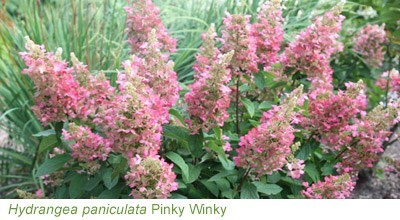
Pinky-Winky (‘Dvppinky’) is another smaller hydrangea suitable for containers or smaller gardens. The conical heads of upright flowers open lime green and then the purple-pink tints develop with age, picking up the colour of the red stems. The shimmering effect of lime green and pink, altogether on each spice-scented flower, gives a look of strawberries and cream in a border.
If size matters plant ‘Silver Dollar’, a vision in white with airy panicles of flowers that don’t turn pink held on upright branches. The flowerheads are loosely arranged to create a lacecap effect and this is often the most admired of all because it’s tastefully elegant. For more spectacular pink and white flowers opt for ‘Vanille Fraise’ which looks like an ice cream sundae in flower. Cut it back hard for enormous flowers.
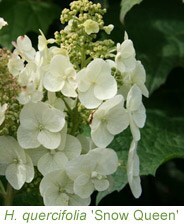 Some hydrangeas not only provide flower, they also provide colourful foliage in autumn. The oak-leaved American hydrangea, H. quercifolia, has leaves that develop rust-red tones in autumn. The curtseying habit make it eminently suitable in containers or in the front of the border. It’s also very good at lolling over low walls. ‘Snow Queen’ has white flowers that turn pink and then produce brown seed heads. ‘Snowflake’ has double white flowers that display lots of cool green. These cool toned whites should be given dappled shade. Some hydrangeas not only provide flower, they also provide colourful foliage in autumn. The oak-leaved American hydrangea, H. quercifolia, has leaves that develop rust-red tones in autumn. The curtseying habit make it eminently suitable in containers or in the front of the border. It’s also very good at lolling over low walls. ‘Snow Queen’ has white flowers that turn pink and then produce brown seed heads. ‘Snowflake’ has double white flowers that display lots of cool green. These cool toned whites should be given dappled shade.
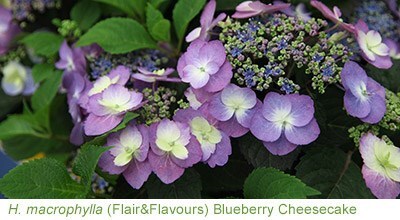
The much daintier Japanese species H. serrata, named because of its toothed oval foliage, bears lacecap flowers and provides red glints in autumn. ‘Blueberry Cheesecake’ will need acid soil, or applications of hydrangea colourant, to provide purplish blue, white centred flowers. Left to its own devices it will produce deep pink flowers in most gardens which tend to have alkaline or neutral soil. These smaller hydrangeas are grown in pots by Japanese gardeners, who adore them. These dainty hydrangeas look best as single specimens in pots, or at the front of a border in some sun. H.serrata doesn’t like deep shade.
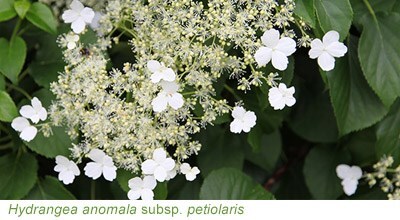
One hydrangea positively revels in shade and will even climb a north-facing wall. Hydrangea anomala subsp. petiolaris will make a dank corner look much lovelier. The adventitious roots will cling to a wall and, once established, this wispy lacecap will provide a pincushion of tiny white flowers surrounded by the occasional full floret, on this self-supporting deciduous climber. Any pruning takes place in autumn, and the regime must be light, for this wall climber flowers on last year’s wood.
Shrubby hydrangeas can be grown as specimens on their own, or used to form hedge-like divisions in the garden. They prefer summer moisture and must be watered in their first two growing seasons if the summer is dry. They also fit into the mixed border well because their gently domed flowers resemble some herbaceous plants - such as eupatoriums. You could also plant the ornamental elder Sambucus nigra f. porphyrophylla 'Gerda' which will give you dark foliage and raspberry-pink flowers. If this is cut back hard, almost to the ground, the foliage will be more sumptuous and the flower less. Cotinus, or smoke bush, can be treated in the same way. |

















